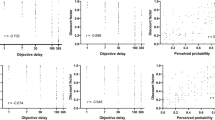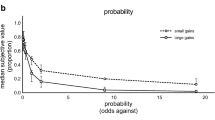Abstract
This study examines the effects of the interaction of two types of information about delays—information about the duration of a delay (delay duration information) and information about the reason for a delay (delay reason information)—on people’s reactions to delays. In this paper, we argue and demonstrate that the two types of delay information interact to affect attribution for the delay and perceived delay duration. The results obtained from an experimental study indicated that there was a stronger effect of delay reason information on attribution for the delay when delay duration information was absent than when the information was present. When no reason was given for the delay, the subjects attributed greater control to the service provider and perceived the delay to be longer when delay duration information was absent than when the information was present.
Similar content being viewed by others
References
Antonides, G., Verhoef, P.C., & Van Aalst, M. (2002). Consumer perception and evaluation of waiting time: a field experiment. Journal of Consumer Psychology, 12(3), 193–202.
Averill, J.R. (1973). Personal control over aversive stimuli and its relationship to stress. Psychological Bulletin, 80(4), 286–303.
Baker, J., & Cameron, M. (1996). The effects of the service environment on affect and consumer perception of waiting time: An integrative review and research propositions. Journal of the Academy of Marketing Science, 24, 338–349.
Bitner, M.J. (1990). Evaluating service encounters: The effects of physical surroundings and employee responses. Journal of Marketing, 54, 69–82.
Bolton, R.N., & Drew, J.H. (1994). Linking customer satisfaction to service operations and outcomes. In Rust, R.T. & Oliver, R.L. (eds.), Service quality: New directions in theory and practice, London: Sage, pp. 173–200.
Burger, J.M., & Hemans, L.T. (1988). Desire for control and the use of attribution processes. Journal of Personality, 56(3), 531–546.
Chebat, J.-C., Filiatrault, P., Gelinas-Chebat, C., & Vaninsky, A. (1995). Impact of waiting attribution & consumer’s mood on perceived quality. Journal of Business Research, 34(3), 191–196.
Durrande-Moreau, A. (1999). Waiting for service: ten years of empirical research. International Journal of Service Industry Management, 10(2), 171–189.
Flaherty, M.G. (1999). A watched pot: how we experienced time. New York: New York University Press.
Forsyth, D.R. (1980). The functions of attributions. Social Psychology Quarterly, 43, 184–189.
Harvey, J.H., & Weary, G. (1984). Current issues in attribution theory and research. Annual Review of Psychology, 35, 427–459.
Hornik, J. (1984). Subjective vs. objective time measures: a note on the perception of time in consumer behavior. Journal of Consumer Research, 11, 615–618.
Hui, M.K., Thakor, M.V., & R. Gill (1998). The effect of delay type and service stage on consumers’ reactions to waiting. Journal of Consumer Research, 24(4), 469–479.
Hui, M.K., & Tse, D.K. (1996). What to tell consumers in waits of different lengths: an integrative model of service evaluation. Journal of Marketing, 60, 81–90.
Jacoby, J., Szybillo, G.J. & Berning, C.K. (1976). Time and consumer behavior: an interdisciplinary overview. Journal of Consumer Research, 2, 320–339.
Johnston, R. (1994). Exploring the relationship between service transactions and satisfaction with overall service. International Journal of Service Industry Management, 6(2), 46–61.
Katz, K.L., Larson, B.M., & Larson, R.C. (1987). Prescription for the waiting-in-line blues: entertain, enlighten, & engage. Sloan Management Review, 32, 44–53.
Kelley, H.H. (1972). Attribution in social interaction. Morristown. NJ: General, Learning Press.
Keppel, G., & Zedeck, S. (1989). Data analysis for research designs: Analysis of variance and multiple regression/correlation approaches. New York: W. H. Freeman.
Krishnamurthy, P., & Kumar, P. (2002). Self-other discrepancies in waiting time decisions. Organizational Behavior and Human Decision Processes, 87(2), 207–226.
Lerner, M.J., & Miller, D.T. (1978). Just world research and the attribution process: Looking back and ahead. Psychological Bulletin, 85(5), 1030–1051.
Maister, D.H. (1985). The psychology of waiting in lines. In Czepiel, J.A. Solomon, M.R., & Surprenant, C.F. (eds.), The service encounter, Lexington, MA: Lexington Books, pp. 113–123.
Miller, D.T., & Porter, C.A. (1988). Errors and biases in the attribution process. In Abramson, L.Y. (ed.), Social cognition and clinical psychology: A synthesis. New York: Guilford Press, pp. 3–30.
Mowen, J.C., & Mowen, M.M. (1991). Time and outcome valuation: Implications for marketing decision making. Journal of Marketing, 55, 54–62.
Oliver, R.L. (1980). A cognitive model of the antecedents and consequences of satisfaction decisions. Journal of Marketing Research, 17, 460–469.
Osuna, E.E. (1985). The psychological cost of waiting. Journal of Mathematical Psychology, 29(1), 82–105.
Pittman, T.S., Stephenson, B., & Swann, W.B. (1981). Curiosity and control: on the determinants of the search for social knowledge. Journal of Personality and Social Psychology, 40, 635–642.
Pruyn, A., & Smidts, A. (1998). Effects of waiting on the satisfaction with the service: beyond objective time measures. International Journal of Research in Marketing 15(4), 321–334.
Ross, L. (1977). The intuitive psychologist and his shortcomings: distortions in the attribution process. In Berkowitz, L. (ed.), Advances in experimental social psychology, New York: Academic, (11).
Russell, D. (1982). The causal dimension scale: a measure of how individuals perceive causes. Journal of Personality and Social Psychology, 42, 1137–1145.
Seligman, M.E.P. (1975). Helplessness. San Francisco: Freeman.
Taylor, S., & Claxton, J. (1994). Delays and the dynamics of service evaluations. Journal of Academy of Marketing Science, 22(3), 254–264.
Tse, D.K., & Wilton, P.T. (1988). Models of consumer satisfaction formation: an extension. Journal of Marketing Research, 25, 204–212.
Zakay, D. (1989). Subjective time and attentional resource allocation: an integrated model of time estimation. In Levin, I. & Zakay, D. (eds.), Time and human cognition: A life-span perspective, The Netherlands: Elsevier Science, pp. 365–397.
Zeithaml, V.A., Berry, L.L., & Parasuraman, A. (1993). The nature and determinants of customer expectations of service. Journal of the Academy of Marketing Science, 21, 1–12.
Author information
Authors and Affiliations
Corresponding author
Rights and permissions
About this article
Cite this article
Hui, M.K., Tse, A.C. & Zhou, L. Interaction between two types of information on reactions to delays. Market Lett 17, 151–162 (2006). https://doi.org/10.1007/s11002-006-5927-3
Issue Date:
DOI: https://doi.org/10.1007/s11002-006-5927-3




